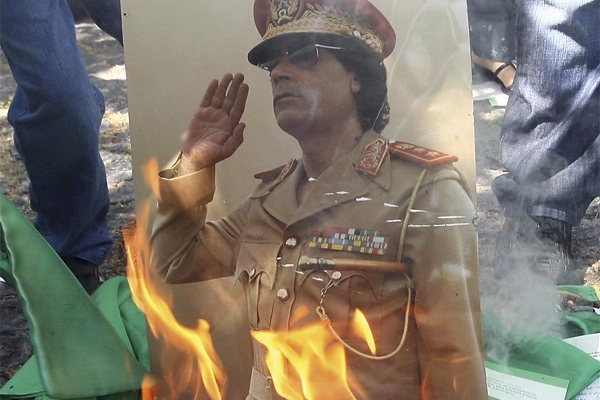The date that rebel leaders chose for the final assault on Tripoli was auspicious: 20 August 2011 coincided with the 20th day of Ramadan by the Muslim lunar calendar, the date on which Muslim forces led by the Prophet Muhammad conquered the holy city of Mecca for Islamic rule in AD 680. It was also exactly six months since the Libyan people had risen against Colonel Muammar Gaddafi and his regime.
The nomenclature of the operation — Mermaid Dawn — was no less bizarre than the regime it sought to overturn. Neighbourhood co-ordinators roused sleeper cells with the agreed code phrase ‘We’re going to have soup tonight.’ After sunset, when Muslims broke their Ramadan fast, the assault began. So thorough was the secrecy that neighbours surprised one another by responding to the call. ‘I thought I would be the only one on my street with a gun,’ one man told Channel 4 News’s International Editor, Lindsey Hilsum, ‘but when I came out I found 50 of my neighbours had guns.’ That night, Gaddafi and his regime were driven from power. The Libyan dictator met his violent end two months later, on 20 October, when his home town of Sirte fell to the rebels.
Hilsum’s book demonstrates conclusively that no Arab people had more reason to demand the fall of the regime in 2011 than the Libyans under Gaddafi. He squandered the wealth of the nation, leaving his oil-rich country chronically underdeveloped. He imposed his dysfunctional ‘government of the masses’ as the alternative to a state. He insulted their intelligence with the political delusions of his little Green Book, which was taught in Libyan schools as doctrine. (It comes as no surprise that one of the first acts of defiance against Gaddafi was the destruction of one of the ubiquitous concrete statues of the Green Book in the eastern town of Tobruk in February 2011.) Worst of all, he imprisoned, tortured and executed the Libyans to preserve his grip on power through fear. For 42 years it worked.
Central to Hilsum’s story is the 1996 massacre in Tripoli’s notorious Abu Salim prison. Few who entered Abu Salim ever expected to leave. Prisoners, alternating between torture, solitary confinement and overcrowded cells, often went mad or died of illness. When a group of inmates rioted in June 1996, they were lured into a central courtyard of the prison and summarily executed by their guards — some 1,300 men in all. Hilsum interviewed former inmates of the prison, survivors of the massacre and relatives of those who did not survive. What most shocked her was that the regime refused to inform the families of the prisoners’ deaths. For 14 years, family members continued to bring food and clothing to the dead, while the officials preserved the fiction they were still alive.
Gaddafi did not confine his depredations to the unfortunate people of Libya. His support for violent political movements, justified as his contribution to the global revolutionary struggle against imperialism, put Libya’s oil wealth at the disposal of many unsavoury movements like the Japanese Red Army and the Palestinian Abu Nidal Organisation. The Semtex of IRA bombings was all of Libyan origin. He was responsible for a number of wars in Africa. There were the bombings of a Pan-Am jet over Lockerbie, Scotland, in 1988, and of a French passenger jet in 1989. For his support of terrorism, Gaddafi saw his country bombed by the US in 1986 and isolated by international sanctions.
Hilsum follows the reversals in western policies to Libya with a critical eye. When Gaddafi was persuaded to surrender his nuclear and chemical weapons programmes in December 2003, Britain and America led in his rehabilitation. Winning a radical over to the west at the height of the war on werror, and opening the Libyan market to western contractors, were motive enough for George Bush and Tony Blair to embrace the Libyan. Yet the west never really lost its distaste for the self-declared ‘Brother Leader’. The British, French and Americans quickly turned on the Gaddafi regime in March 2011 when he threatened a massacre in Benghazi. No doubt Gaddafi felt betrayed by his fickle western partners, having surrendered the very weapons that might have made Nato hesitate to attack him. Yet as this book reveals, the horrors at the heart of his regime should have placed Gaddafi beyond rehabilitation.
Hilsum has written a gripping account of the roots of revolution in Libya. Through extensive interviews with scores of Libyans before, during and after the conflict, she allows the people behind the revolution to tell their stories to the western reader. Her sharp analysis and careful piecing together of the story endow her work with qualities that will prove of lasting value to students of Libya’s 2011 revolution.






Comments